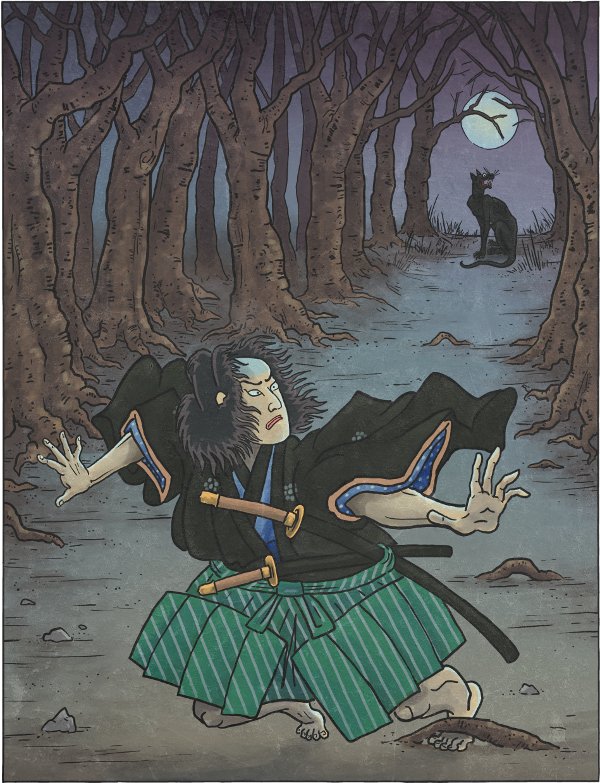Today’s yokai is related to Tuesday’s yosuzume. And it is another dog yokai, for all of you dog lovers out there!

Okuriinu
Okuri-inu (送り犬)
Okuri-inu means “sending-off dog.” It is also known as okuri-ōkami, or “sending-off wolf,” as this yokai is known the appear is both wild dog and wolf forms. The “sending-off” part of the name comes from the fact that these animal yokai follow closely behind travelers, trailing behind them as if they were sending them off on their way. Of course, friends who send you off rarely rip you to pieces when you fall down…
This superstition is extremely old, and found in all parts of Japan; certainly wolves and superstitions surrounding them have existed for as long as humans have existed on the Japanese isles, and the legend of the okuri-inu must have originated in the mists of pre-historic Japan. Basically, this yokai is a wolf or a dog that follows travelers late on the road at night. It stalks them, keeping a safe distance, but following footstep for footstep, as long as they keep walking. If the traveler should trip or stumble, the okuri-inu will pounce on them and rip them to shreds.
The okuri-inu is a double-edged sword of a yokai. On the one hand, if you should trip and fall, it will pounce on you with supernatural speed and gobble you up. On the other hand, though, they are so ferocious that while they are following you, no other yokai or wild animals will come close. (In the old days, wild dogs and wolves were a serious problem for foot travelers making the dangerous night-time journeys through wild mountain passes.) As long as you keep your footing, you are safe… but traveling in the dark over root-infested, rocky mountain footpaths, especially while carrying a large pack of whatever it is you are going to sell does not make for easy footing!
There are two asterisks to add to this story. One is the other day’s yokai, the yosuzume. This creepy bird’s night-time song is often a warning that an okuri-inu is following you. If you should hear the yosuzume’s chi, chi, chi song, then you can take extra care to watch your footing so that the okuri-inu trailing you doesn’t have dinner that night.
The other one cracks me up. Apparently, if you should stumble, as long as you fake it so it looks like you did it on purpose, the okuri-inu will be tricked into thinking you are just taking a rest, and it won’t pursue. You do this by saying “dokko-isho” (“Heave-ho!”) or “shindoi wa” (“This is exhausting!”) and quickly fixing yourself into a sitting position. Sigh, sit for a bit, then continue on your way and the okuri-inu will wait patiently for you.
Some areas have followups to the story as well. If you should make it out of the mountains safely, you should turn around and say, “Thanks for seeing me off!” Afterwards, it will never follow you again. Further, when you get home, you should wash your feet and leave out a dish of something for the okuri-inu to show your gratitude for it watching over you.
In Izu and Saitama, the okuri-inu has a friend known as the okuri-itachi. This is a weasel that works in roughly the same way as the okuri-inu, only that if you take off one of your shoes and throw it at it, the weasel will eat the shoe and run away, leaving you in peace.
Finally, in modern Japanese, the word okuri-ōkami also applies to predatory men who go after young women, pretending to be sweet and helpful but with ulterior motives… That word comes straight from this yokai!
Are you interested in yokai? Can’t get enough of strange Japanese culture? Then you should check out my book, The Night Parade of One Hundred Demons, on Amazon.com and learn the story behind over one hundred of these bizarre monsters! | 今日の妖怪は火曜日の夜雀に関係しているもので、今回も犬の妖怪ですので犬好きの方にお勧めの妖怪ですよ!

Okuriinu
Okuri-inu (送り犬)
送り犬は送り狼とも呼ばれ、野犬か狼の姿をしており、“送り”という言葉はこの妖怪が旅人を送り届けるかのように背後について歩く習性からきている。もちろん、本当に送ってくれる友達は、転んだ人間をバラバラに切り刻む事はしないでしょうが…。
送り犬にまつわる言い伝えは古くからあり、日本各地に存在している。狼にまつわる話は確かに人間が存在する昔から伝えれており、送り犬はその大昔の伝説が起源となっていると思われる。基本的に、この狼か犬の妖怪は夜旅人の後をつけるといわれており、彼らは人の後ろにぴったりとついて一足ずつ共に歩くのだそうだ。もし旅人が転んでしまった場合は、その獲物に飛びかかって食らいついて襲うのだという。
送り犬には2つの面がある。一つは転んだ人間に勢いよく襲いかかるというもので、もう一つは送り犬が側にいる間はその凶暴さのため他の野獣は近くに寄ってこないというものである(かつての日本では野犬や狼は、夜の山道を徒歩で歩く旅人にとっては深刻な問題であった)。足元に気をつけ転ばぬようにしておけは安全であるが…しかし暗闇の山道、岩道があったり木の根があったりする中で通行するのは難しく、ましてや町で商いをするために大きな荷物を携えていたりするならば、それはそれは困難な道中になるでしょう。
今週紹介した夜雀であるが、これは送り犬がくる前触れとして現れる気味の悪い雀の大群であった。もし夜雀の「チッチッチ」という鳴き声を聞いたなら、旅人は足元により一層の注意を払わなければ送り犬の今夜の夕食になってしまうという事だ。
他にも送り犬にまつわる話は数多くある。一つは例え転んでしまったとしても、それをわざと“転んでいない”ように振舞うことで送り犬はただ休んだだけかと勘違いして襲ってこないのだというものである。例えば、転んだ拍子に「どっこいしょ」と休んだように言ったり、「しんどいわぁ」と疲れて座ったかのように見せかけたりすると送り犬は襲ってはこずにその場で待っているのだという。そしてその後も旅を続ける人間の後を根気強くついて歩くのである。
他の地域にはその続きの話もある。もし何事もなく山を通り抜ける事が出来たなら、振り返って送ってくれたお礼を述べるともうその後追ってくることはないのだという。さらに、家にたどり着いた後は足を洗い流し無事帰れた事への感謝として外に何か一品供えておくと良いとの話もある。
静岡県と埼玉県では、送り鼬という送り犬の仲間が伝えられている。大体は送り犬と同じであるが、送り鼬には履いている草履を片方投げるとそれを咥えて去っていくという言い伝えがある。
最後に、日本で現代も使われている「送り狼」という用語であるが、これは本心を隠して若い女性に親切に振舞い、隙あらば乱暴しようと企む男をさすものである。この用語も、この妖怪からきたものであると分かる。
他の妖怪にも興味をもっていただけたなら、是非アマゾンから「The Night Parade of One Hundred Demons(百鬼夜行)」をどうぞ!



